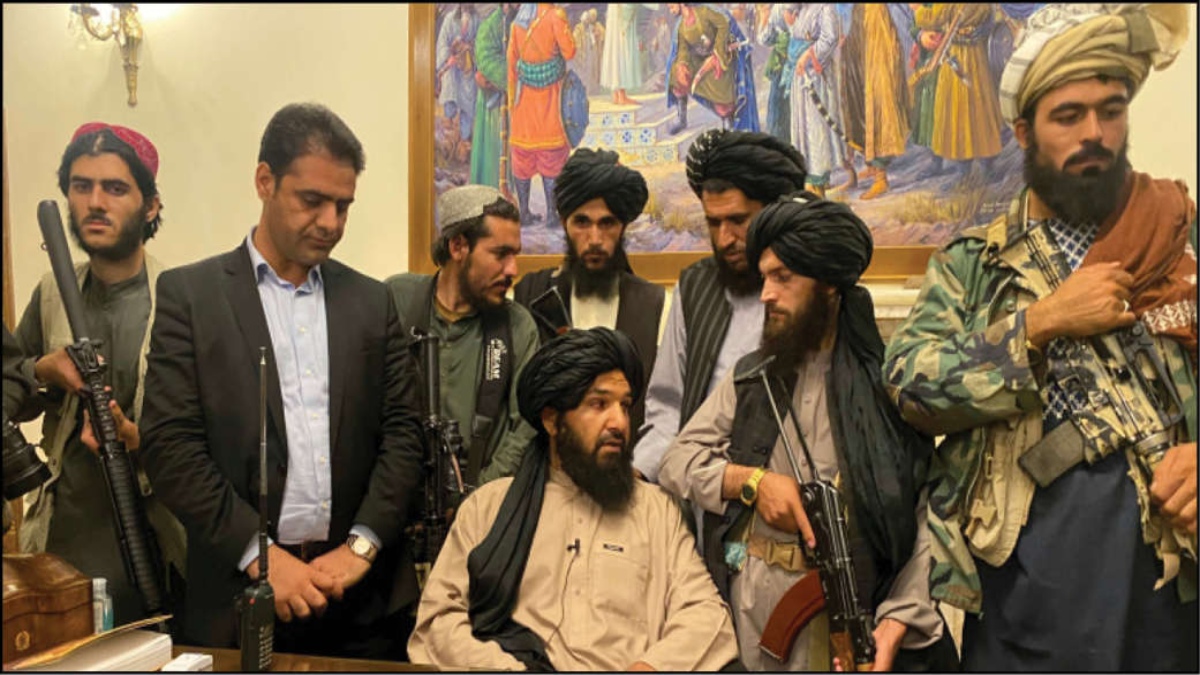As the Americans left Afghanistan, the Taliban were seen in gunfire celebrations of their victory. Gun-toting Taliban fighters moving around in American vehicles and American uniforms, the future of Afghanistan is acutely chaotic. The nature, structure and scope of the Afghanistan government are very sketchy. However Afghanistan has certainly emerged to be the epicentre of several shades of Islamist radicalism which will have debilitating impact on Asian geopolitics in several ways.
With American arms and ammunition virtually donated to the Taliban, there is a great arms bazaar and its devastating implications bound to be felt in West Asia, South Asia and Central Asia. It may also find its way to Xinjiang province—China’s Islamic underbelly. While these seem scary to the peace and security of the region, the emerging consequences are likely to be far more dreaded than that meets the eye. The Americans possibly have scripted a much deeper chaos and engineered two major structural and normative designs that may keep the Asian geopolitics at boiling point for some time to come. First design pertains to Samuel Huntington’s ‘Clash of Civilisations’ imagined way back in 1993. Second, American withdrawal leaves a leadership vacuum and prospect for all shades of regional strategic realignments that may push the region into a ‘Kindleberger Trap’ too.
WASHINGTON’S ARMS BAZAAR IN AFGHANISTAN
Washington seems to have spent over $83 billion in Afghanistan since 2001 to train and equip the Afghan army (NDS) that quickly melted away as the Taliban approached Kabul. As per Special Inspector General for Afghanistan Reconstruction (SIGAR) report, since 2003, the United States has provided Afghan forces with at least 600,000 light weapons such as M-16 and M-4 rifles, 76,000 vehicles, 16,000 night-vision goggles, 162,000 radios and other communications equipment. As per the SIGAR report, Washington’s recent 2017-19 arms supplies include 4,700 Humvees, 20,000 hand grenades and thousands of small munitions and grenade launchers et al.
Soon these weapons would need repair, servicing, maintenance systems and spare parts. They will also need replenishment including such supplies to opposite forces facilitating a full-fledged weapons market operating from Kabul.
The bigger question is: Are the Americans so naïve that they left such quantities of weapons innocently? It is unimaginable that Americans who forged NATO, engineered the fall of their Cold War bête noire Soviet Union, masterminded devastation of the Middle East, and now trying to contain China are as innocent and naïve. Instead, it could well be a conspicuous plan to push Afghanistan into chaos and Islamic radicalism to keep the Asian geopolitics at tenterhooks.
AFGHAN PEACE: THE AMERICAN WAY
Way back in the early 1990s, former editor of Foreign Affairs magazine Samuel Huntington became very popular for his ‘Clash of Civilisations’ hypothesis. Huntington imagined international geopolitics in the post-Cold War to be more and more galvanising into religious and identity-based confrontations where finally Christianity, Islam and Confucianism shall tussle over dominance. Egypt to Afghanistan and West Asia included, the region is now more known as the ‘conflict crescent’ of the world. Thanks to American ingenuity, the Middle East already is in flames and now Afghanistan completes the Conflict Crescent with all possible implications to Pakistan, India and several parts of Asian geopolitical space.
Americans came to Afghanistan two decades ago to impose American-guided peace. For market consumption, they also orchestrated the Doha peace agreement. With all their statesmanship and geopolitical wisdom, Washington signed the Doha peace agreement with the Taliban without involving the ruling government of the country. Finally, conspicuously, they deserted the beleaguered nation to the Taliban with around $85 billion worth of arms and ammunition gift so that Afghanistan and the region remain peaceful.
AFGHANISTAN IN KINDLEBERGER TRAP
American economic historian Charles P. Kindleberger is known for hegemonistic Stability Theory (HST). Kindleberger in his 1978 book Maniacs, Panics, and Crashes: A History of Financial Crises captures the 1930s as the time of market chaos leading to Great Economic Depression and ultimately the arrival of World War II. Kindleberger argues that a hegemon is needed to impose stability in a market failing which, the market may become chaotic and crash. He argues that in the 1930s, Britain was beginning to vacate its international hegemonic role and the rising America didn’t step in to provide stability which led to World War II. The same analogy in geopolitics is known as hegemonistic stability theory. The 1990s American ‘Soft Power’ advocate, Joseph Nye, recaptured the phenomenon as ‘Kindleberger Trap’—absence of hegemonic power as equivalent to geopolitical chaos.
Afghanistan has precisely gotten into a Kindleberger Trap that has every possibility, inclination and motivation to percolate into the greater Asian geopolitical scenario which is already dealing with the pressure of China’s hegemonic rise and its corresponding challenges in the entire Indo-Pacific region.
WASHINGTON’S POSSIBLE END GOAL
The ‘International Order’ is in great transition today. Larger narratives talk of declining ‘Pax Americana’, rising vacuum in the international system, and a possible Kindleberger Trap. The Covid-19 pandemic critically exposed the vulnerability of the United States. Over 658,103 people are already dead in the US as of now which is one of the highest casualty rates in the world. Along with the death toll and their vulnerability exposed, the American economy also crumbled to -3.48% GDP growth rate in 2020 which had not happened even during the peak of the American economic meltdown. American allies in Europe seemed utterly helpless too. For the first time in several centuries, European and North American dominance and the notion of ‘White Supremacy’ seem to be in serious question.
Apart from ‘White Supremacy’ notion being in decline, the rise of Asia is the next big psychological blow to the Anglo-Saxon hegemony protagonists. Non-White, non-Anglo-Saxon Asiatic people rising to fill the vacuum Americans are vacating in international affairs seem to be a stark reality.
American withdrawal from Afghanistan is likely to render Afghanistan and a great part of Asia into a state of insecurity and geopolitical ambivalence. By withdrawing, Americans successfully demonstrated the centrality of their presence as a geopolitical stability axis or the relevance of Kindlebergers’ hegemonistic stability notion.
Afghan peace is not the American or NATO forces’ direct accountability now. However, in the event of rising Islamic radicalism in the region which could well be the case as a direct consequence of American huge arms and weapons left behind, the Americans will have a moral responsibility and authority to deal with it in preferential terms. Instead of spending critical resources in Afghanistan, the Americans may well have wider arms supply and servicing avenues to revive the American economy back to life.
Additionally, American withdrawal from Afghanistan is directly proportional to chaotic power competition in Asia which may deepen Asian geopolitics into a greater chaos and puzzle. Divided and distraught, Asia shall need Washington more as an arms trader and as a peace broker at the same time—difficult time indeed for Asian geopolitics which the Pentagon had visualised back in 1999 Summer in its ‘Asia 2025 Report’.
Rudra P. Pradhan is an Associate Professor at the Department of Humanities & Social Sciences, BITS Pilani, KK Birla Goa Campus and serves as a Distinguished Fellow, Political Economy at Centre for Public Policy (CPPR), Kerala. The views expressed are personal.
Afghan peace is not the American or NATO forces’ direct accountability now. However, in the event of rising Islamic radicalism in the region which could well be the case as a direct consequence of American huge arms and weapons left behind, the Americans will have a moral responsibility and authority to deal with it in preferential terms.























